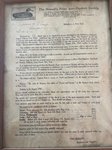Paul Bigelow’s granddaughter, Denise Valenti, joined the Long Island Decoy Collectors Association years ago, to continue her family’s heritage. After noticing both the club and the show …
This item is available in full to subscribers.
We have recently launched a new and improved website. To continue reading, you will need to either log into your subscriber account, or purchase a new subscription.
If you had a login with the previous version of our e-edition, then you already have a login here. You just need to reset your password by clicking here.
If you are a current print subscriber, you can set up a free website account by clicking here.
Otherwise, click here to view your options for subscribing.
Please log in to continue |
|


Paul Bigelow’s granddaughter, Denise Valenti, joined the Long Island Decoy Collectors Association years ago, to continue her family’s heritage. After noticing both the club and the show had very important anniversaries coming up, she got to work.
“I am just glad we’re recognizing them,” she said of the show and the anniversary. “The history is so deep, and it affected conservation. The whole reason the first decoy show came about was because of the Anti-Duskers society.”
This year marks the 100th anniversary of the first decoy show ever held, originally in Bellport. This year also marks the Long Island Decoy Collectors Association’s 50th anniversary. The association has been hosting the same decoy show ever since.
On March 4, the club will host a display about the 100th anniversary at their annual decoy show, to be held at the IBEW Hall in Hauppauge. The LIDCA will also display an exhibit celebrating the collecting of decoys and history for the past 50 years.
The first show, 100 years ago, was organized by the members of the Howell’s Point Anti-Duskers Society, a group who fought against hunting ducks at dusk in an attempt to help preserve the black duck. The group was formed by Paul “The Commodore” Bigelow and his son Paul “Perry” Bigelow, Theodore T. Everitt, John H. B. Boyle and several others. Most of the original members were neighbors and avid duck hunters, who lived near Howell’s Point in Bellport in the early 1920s.
After talking to so many hunters, they were encouraged to bring together everyone for a show to display different carvers and decoys. Their show was originally held in the Bellport Library located on Bellport Lane, which now serves as Village Hall. There were over 200 decoys from 14 states, brought together for the first time.
During the show, held in August 1923, Shang Wheeler’s mallard duck pair won the amateur first place, and changed the direction of decoy making with their almost lifelike carving and painting. The following year, the show moved to New York City. According to Valenti, since then, the popularity of decoy shows has grown and spread across the country.
Inn celebration of the anniversary, on July 4, the Bellport Brookhaven Historical Society will have an exhibit for the first decoy show during Bellport’s Artists on the Lane. The exhibit will be on display at the Post-Crowell House, on Bellport Lane. There will be decoy displays, appraisals, and vendors for buying and selling. Also, Valenti, along with LIDCA president Tim Sieger and past vice president Dick Richardson, will be available for questions.
ABOUT THE SHOW
The Long Island Decoy Collectors Association will be hosting their 51st annual Antique Decoy, Fishing & Sporting Collectibles Show on Saturday, March 4 from 9 a.m. to 4 p.m. at the IBEW Hall in Hauppauge. Admission is $7 and there will be free decoy appraisals. This year’s theme is celebrating 50 years of the association. For more information call Tim Sieger at 631-537 0153, Dick Richardson at 631-475-4199, or Jim Jankowski at 631-721-6914. Or visit www.lidecoycollectors.com.
ABOUT THE ORIGINAL SHOW
The 1923 show had about 200 entries representing 50 participants from 14 states. John Boyle and Paul Bigelow, who was a college student at the time, visited Joe Barber of Babylon, Wilbur Corwin of Bellport, and others to collect old decoys for the exhibit. The committee decided to have a carver’s competition with two classes, professional and amateur. The top professional prize was $25; George Macintosh, of Bellport, won for his pair of cork black ducks. The top amateur prize was a silver cup won by Charles Shang Wheeler, of Connecticut, for his pair of mallards. The judges were Gil Smith of Patchogue, Paul Curtis of New York City, and Roland Clark of Peconic. Criteria for judging included shape, coloration, workmanship, paint finish, and details.
ABOUT THE ANTI-DUSKERS
Shooting after dusk at ducks silhouetted against the darkening sky was a common practice at the time and particularly destructive for black ducks due to their feeding habits, according to the club. The society was formed to arouse public outcry to ban the practice and save the nearly extinct black ducks, which are still around today.
Comments
No comments on this item Please log in to comment by clicking here